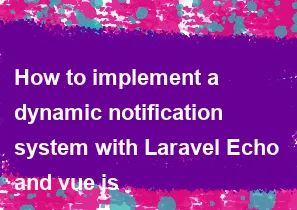How to implement a dynamic notification system with Laravel Echo and vue js

Implementing a dynamic notification system with Laravel Echo and Vue.js involves setting up a real-time messaging system using Laravel Echo and broadcasting events. Here's a step-by-step guide to help you achieve this:
Prerequisites:
- Make sure you have Laravel and Vue.js installed in your project.
- Set up Laravel Echo and a broadcasting driver (e.g., Redis or Pusher).
Step 1: Set Up Broadcasting
- Configure your
broadcasting.phpfile located in theconfigdirectory. Set thedefaultdriver to 'pusher' or 'redis' depending on your preference.
php// config/broadcasting.php
'default' => env('BROADCAST_DRIVER', 'pusher'),
// Add Pusher configuration if you choose Pusher
'pusher' => [
'driver' => 'pusher',
'key' => env('PUSHER_APP_KEY'),
'secret' => env('PUSHER_APP_SECRET'),
'app_id' => env('PUSHER_APP_ID'),
'options' => [
'cluster' => env('PUSHER_APP_CLUSTER'),
'encrypted' => true,
],
],
// Add Redis configuration if you choose Redis
'redis' => [
'driver' => 'redis',
'connection' => 'default',
],
- Set your broadcasting credentials in the
.envfile.
envBROADCAST_DRIVER=pusher PUSHER_APP_ID=your_pusher_app_id PUSHER_APP_KEY=your_pusher_app_key PUSHER_APP_SECRET=your_pusher_app_secret PUSHER_APP_CLUSTER=your_pusher_cluster # OR, if you choose Redis REDIS_HOST=127.0.0.1 REDIS_PASSWORD=null REDIS_PORT=6379
Step 2: Create an Event
Create a Laravel event that will be broadcasted when a notification occurs.
bashphp artisan make:event NotificationEvent
Edit the generated NotificationEvent class:
php// app/Events/NotificationEvent.php
class NotificationEvent implements ShouldBroadcast
{
public $message;
public function __construct($message)
{
$this->message = $message;
}
public function broadcastOn()
{
return new Channel('notifications');
}
}
Step 3: Broadcast the Event
Broadcast the event when a notification occurs. You can do this in your controller, service, or wherever you generate notifications.
php// ExampleController.php
use App\Events\NotificationEvent;
public function sendNotification()
{
$message = 'New notification message';
event(new NotificationEvent($message));
return response()->json(['message' => 'Notification sent!']);
}
Step 4: Listen for the Event in Vue Component
Set up your Vue component to listen for the notifications using Laravel Echo.
javascript// resources/js/components/NotificationComponent.vue
<template>
<div>
<ul>
<li v-for="notification in notifications" :key="notification.id">
{{ notification.message }}
</li>
</ul>
</div>
</template>
<script>
export default {
data() {
return {
notifications: [],
};
},
mounted() {
Echo.channel('notifications')
.listen('NotificationEvent', (event) => {
this.notifications.push(event);
});
},
};
</script>
Step 5: Include the Component
Include your Vue component wherever you want to display the notifications.
html<!-- resources/views/welcome.blade.php -->
@extends('layouts.app')
@section('content')
<notification-component></notification-component>
@endsection
Step 6: Run Your Application
Make sure your Laravel application is running and Laravel Echo server is active if you're using Redis or a queue driver.
bashphp artisan serve
# Run Laravel Echo server in a separate terminal window
laravel-echo-server start
Now, when you trigger a notification in your Laravel application, it should be dynamically displayed in your Vue.js component in real-time.
-
Popular Post
- How to optimize for Google's About This Result feature for local businesses
- How to implement multi-language support in an Express.js application
- How to handle and optimize for changes in mobile search behavior
- How to handle CORS in a Node.js application
- How to use Vue.js with a UI framework (e.g., Vuetify, Element UI)
- How to configure Laravel Telescope for monitoring and profiling API requests
- How to create a command-line tool using the Commander.js library in Node.js
- How to implement code splitting in a React.js application
- How to use the AWS SDK for Node.js to interact with various AWS services
- How to use the Node.js Stream API for efficient data processing
- How to implement a cookie parser middleware in Node.js
- How to implement WebSockets for real-time communication in React
-
Latest Post
- How to implement a dynamic form with dynamic field styling based on user input in Next.js
- How to create a custom hook for handling user interactions with the browser's device motion in Next.js
- How to create a custom hook for handling user interactions with the browser's battery status in Next.js
- How to implement a dynamic form with dynamic field visibility based on user input in Next.js
- How to implement a dynamic form with real-time collaboration features in Next.js
- How to create a custom hook for handling user interactions with the browser's media devices in Next.js
- How to use the useSWRInfinite hook for paginating data with a custom loading indicator in Next.js
- How to create a custom hook for handling user interactions with the browser's network status in Next.js
- How to create a custom hook for handling user interactions with the browser's location in Next.js
- How to implement a dynamic form with multi-language support in Next.js
- How to create a custom hook for handling user interactions with the browser's ambient light sensor in Next.js
- How to use the useHover hook for creating interactive image zoom effects in Next.js